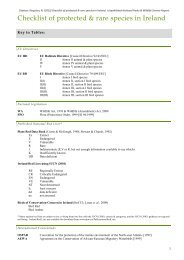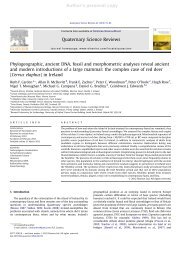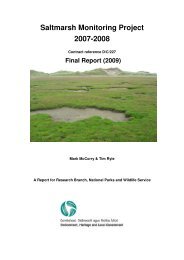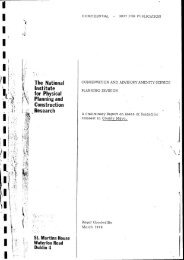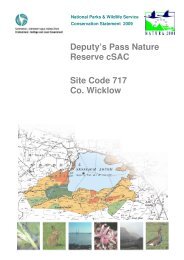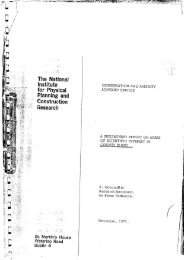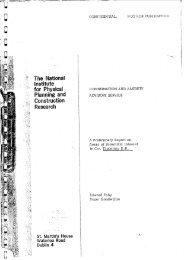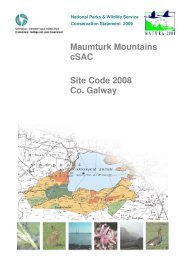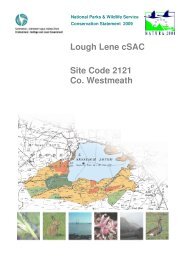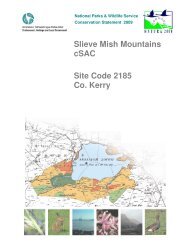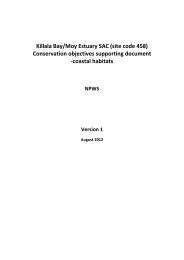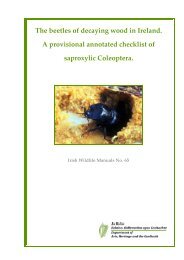The Role of Kelp in the Marine Environment - National Parks ...
The Role of Kelp in the Marine Environment - National Parks ...
The Role of Kelp in the Marine Environment - National Parks ...
You also want an ePaper? Increase the reach of your titles
YUMPU automatically turns print PDFs into web optimized ePapers that Google loves.
whereas o<strong>the</strong>r lam<strong>in</strong>arian species <strong>of</strong> <strong>the</strong> upper sublittoral zone generally live no longer<br />
than 3 - 4 years (Lün<strong>in</strong>g, op. cit.) although Gunnarson (1991) reported 25 years old L.<br />
hyperborea plants from Iceland.<br />
<strong>The</strong> biological cycle and growth <strong>of</strong> <strong>the</strong> Lam<strong>in</strong>ariaceae is well documented. <strong>The</strong> life<br />
cycle <strong>of</strong> Lam<strong>in</strong>aria digitata has been known s<strong>in</strong>ce Sauvageau (1918). Lam<strong>in</strong>aria<br />
plants have a two stage life cycle <strong>in</strong> which a large diploid thallus (compris<strong>in</strong>g<br />
holdfast, stipe and blade) produce haploid spores which germ<strong>in</strong>ate to produce a nearly<br />
microscopic plant (<strong>the</strong> gametophyte) that <strong>in</strong> turn produces haploid male and female<br />
gametes. Fusion <strong>of</strong> <strong>the</strong> gametes gives rise to <strong>the</strong> diploid or sporophyte phase. <strong>The</strong><br />
overwhelm<strong>in</strong>g bulk <strong>of</strong> primary production <strong>in</strong> <strong>the</strong> species is produced by <strong>the</strong><br />
sporophyte. Reproduction is from July until <strong>the</strong> end <strong>of</strong> <strong>the</strong> year/spr<strong>in</strong>g. <strong>The</strong> spores<br />
are produced <strong>in</strong> visible dark patches on <strong>the</strong> blade termed sori (s<strong>in</strong>gle = sorus).<br />
Flagellate zoospores are shed <strong>in</strong> two seasonal peaks one <strong>in</strong> July and one <strong>in</strong> November.<br />
<strong>The</strong> sporophyte becomes mature after 18 months, reach<strong>in</strong>g maximum fertility at 3<br />
years. Plants can live for 5 years <strong>in</strong> sheltered places. L. hyperborea can live for more<br />
than 12 years with an average <strong>of</strong> 8 years; <strong>the</strong>y reach maturity after two years and are<br />
fertile dur<strong>in</strong>g w<strong>in</strong>ter.<br />
Growth <strong>in</strong> all Lam<strong>in</strong>aria species is meristematic. <strong>The</strong> meristem (or cell division area)<br />
is located between <strong>the</strong> stipe and blade. <strong>The</strong> stipe always exhibits positive growth<br />
while <strong>the</strong> blade <strong>of</strong> L. digitata <strong>in</strong>creases <strong>in</strong> <strong>the</strong> first six months <strong>of</strong> <strong>the</strong> year but<br />
decreases <strong>in</strong> length dur<strong>in</strong>g <strong>the</strong> last six months due to apical erosion (Cosson, 1978 as<br />
cited <strong>in</strong> Arzel, 1989). In o<strong>the</strong>r words net growth <strong>in</strong> length is a balance between blade<br />
growth at <strong>the</strong> basal meristem and erosion at <strong>the</strong> blade tip. However, on balance,<br />
blade growth exceeds apical blade erosion dur<strong>in</strong>g <strong>the</strong> first three years <strong>of</strong> <strong>the</strong> plant’s<br />
life. Maximum length is reached dur<strong>in</strong>g <strong>the</strong> third year while blade erosion exceeds<br />
growth <strong>in</strong> year four. <strong>The</strong> blade disappears by year five. In L. hyperborea and L.<br />
sacchar<strong>in</strong>a, <strong>the</strong> old blade is shed annually after sporulation. Prior to shedd<strong>in</strong>g, a<br />
constriction or waist appears <strong>in</strong> <strong>the</strong> blade divid<strong>in</strong>g <strong>the</strong> older from <strong>the</strong> younger part.<br />
<strong>The</strong> part that detaches is where <strong>the</strong> sori have developed and <strong>the</strong>n sporulated.<br />
Follow<strong>in</strong>g shedd<strong>in</strong>g, regeneration <strong>of</strong> <strong>the</strong> blade occurs <strong>in</strong> both L. hyperborea and L.<br />
sacchar<strong>in</strong>a.<br />
10



